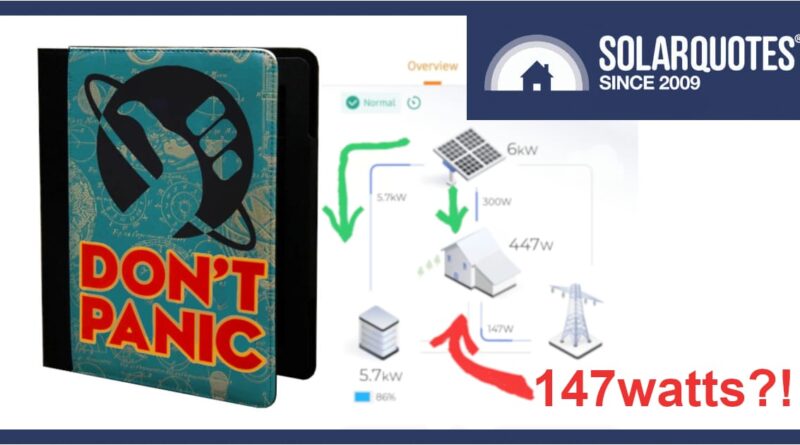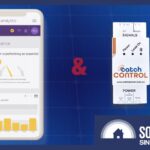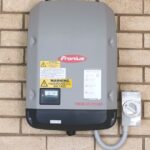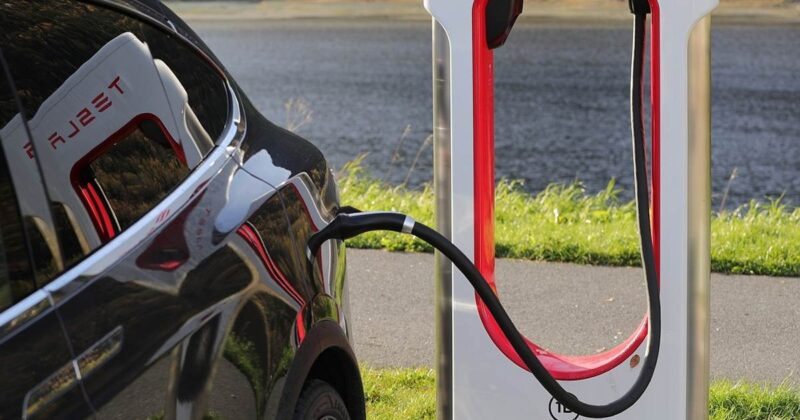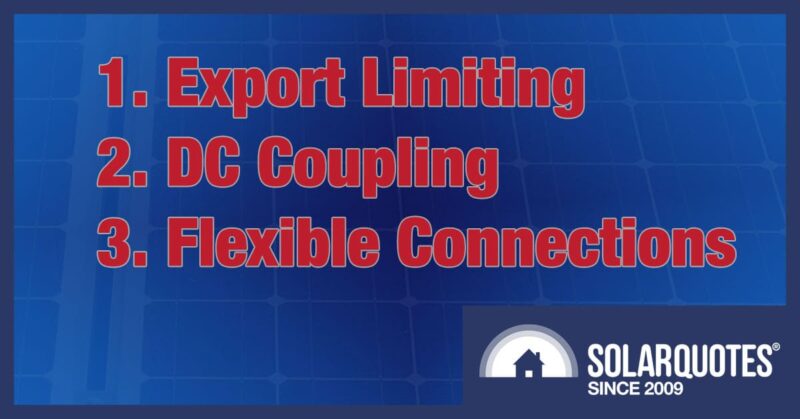Battery Owners: Why You Still See Small Energy Imports Despite a Full Battery
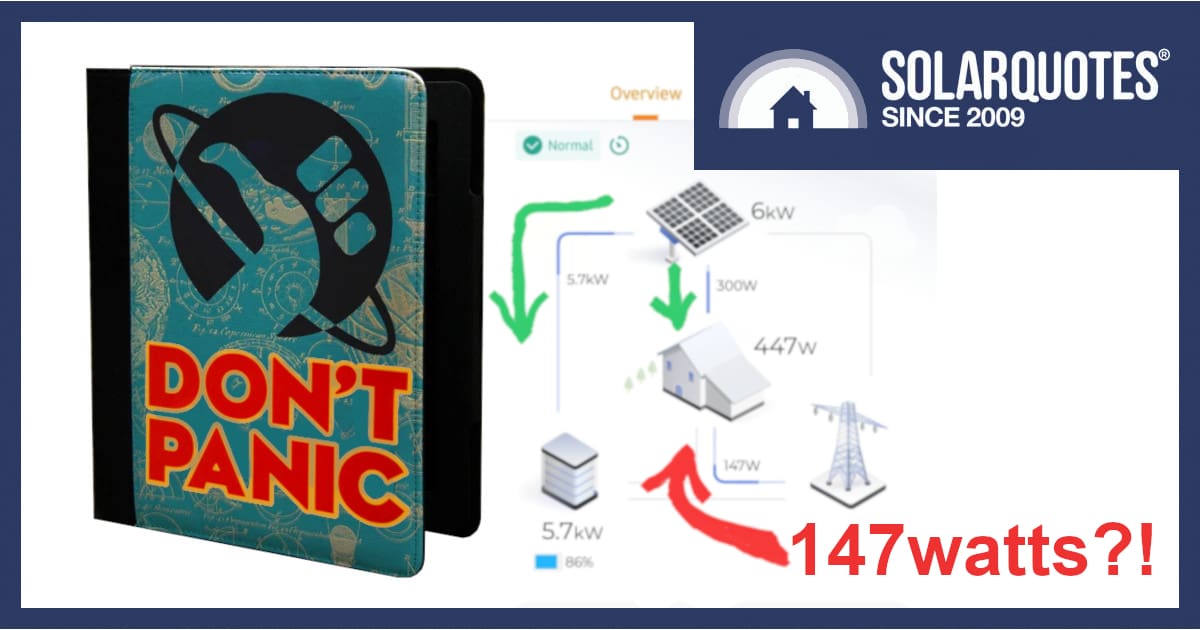
The only thing that’s grown more than electricity bills recently is the number of new solar power systems installed with batteries. I’m guessing a close third is the growth of my inbox, specifically with questions about small unwanted energy imports. Read on while I explain; please, stop emailing me…
Like the Hitchhiker’s Guide To The Galaxy, battery monitoring apps need a cover that reads “Don’t Panic” in large, friendly letters.
It’s easy to be alarmed when your monitoring shows unexpected imports and exports. Before you start taking screenshots and firing off complaints to your installer about a malfunctioning system, let’s break down why this happens and why you needn’t worry.
How Solar + Battery Works
A standard solar power system prioritises energy flow like this:
- First, supply power to your home
- Then, charge the battery, if you have one
- Next, switch on diversion loads, like a hot water service or EV charger
- Finally, send any remaining solar to the grid
With a tricky retail tariff or external control from a VPP retailer, you may want to change the order of these operations, according to time of use tariff, solar yield or even export tariff, however most people just want the bills to be reasonable.
However, some numbers will prove frustrating for those who treat electricity as a hobby, e.g., when energy is being exported and the battery isn’t full. This is because the Battery Management System (BMS) is programmed to use excess solar best and keep the system safe.
Some examples:
The Tesla Powerwall 3 can have 20kW of solar attached, but the battery is the bottleneck; it will only accept 5kW at any given time.
More generally, if batteries’ state of charge is above 80%, the rate at which they will accept energy is limited.
In other words, going from zero to 80% can take the same amount of time as going from 80% to 100%. If you have plenty of midday sunshine available and a 5kW maximum charging rate, your 15kWh battery will take nearly 2½ hours to hit 80% plus another couple of hours to top it off slowly.
So solar energy may be spilled to the grid or throttled by an export limit; even if the battery isn’t completely full. It’s a good reason to have more than one form of storage.
Why Does My Battery Discharge To or Charge From The Grid?
Short answer: It doesn’t if your solar system is properly installed and set up.
Long answer: The consumption meter in your system monitors the flow of energy in and out of your home. In simple terms:
- When it detects that your home is sending energy to the grid, it charges the battery.
- If it sees energy coming in from the grid, it triggers the battery to discharge into your house, so you don’t have to keep importing power.
The key words here are about visibility and timing.
Your system might be clever, but it’s not clairvoyant, so when you switch on the kettle, there must be some energy flow from the grid before the battery will counter it.
Same too for periods of high demand, electricity will follow the path of least resistance, and the grid offers the most robust supply.
If your fridge normally uses 500 watts, it can pull as much as 4000 watts at the moment the compressor starts. Your solar inverter and battery won’t instantly deliver that energy, so the grid makes up the difference. (If the grid wasn’t available, your house lights would probably dip or flicker, and the fridge wouldn’t spin up as quickly)
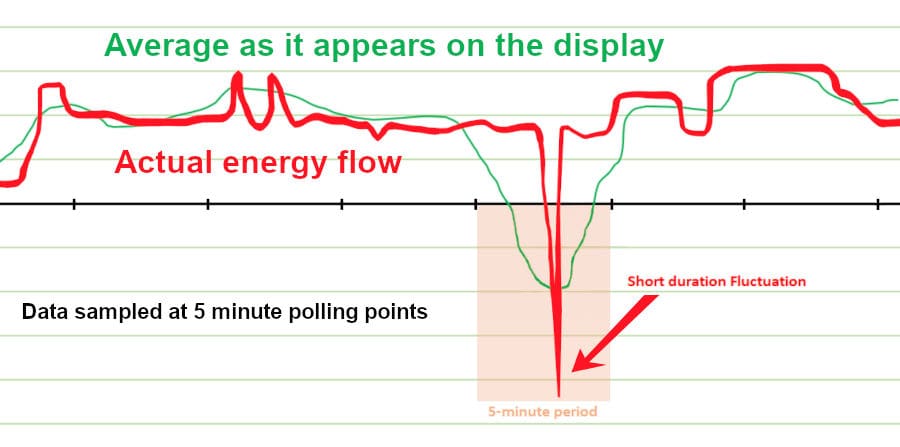
The shaded section shows that solar apps are an average indicator that takes regular snapshots and fills the gaps in between. It’s not a true data-logging device that maps peaks and troughs with split-second accuracy.
So, the battery only charges when your solar system produces more energy than your home needs. It only discharges when your home is using energy from the grid. Of course, there are exceptions:
- If the battery falls below a preset minimum charge, it will pull power from the grid to prevent damage to the cells.
- With a real-time energy plan, retailers like Amber may activate grid charging to get paid for soaking up negatively priced electricity.
- You can manually fill the battery from the grid using a ‘Forced Charge’ setting. This is a handy feature to prepare for a potential grid outage. Tesla calls it a “storm watch,” and control may be tied to a local weather service.
Real-Time Isn’t Really “Real-Time”
Apps like Sungrow’s iSolarCloud don’t show real-time activity. At best, you can turn the kettle on and expect to see the consumption increase before it whistles.
Inverters upload small economical packets of data to the cloud at five-minute intervals, and fill in the gaps with estimates. Small fluctuations might look larger than they are in reality because solar monitoring is an indicator, not a data logging system.
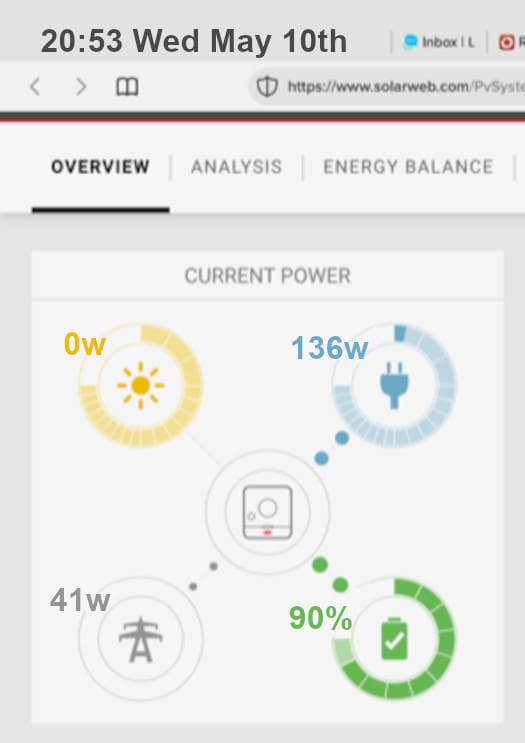
At close to 9pm this is small beans being imported from the grid. Switching the mains off will stop it, but it’ll also make your inverter work much harder and could endanger your warranty if it’s more than 20% of the time.
Filling The Gaps In Reality
Monitoring often uses WiFi to send data. However, obstacles in your home or interference from other devices can weaken the signal, slow down data transmission or cause gaps in the data altogether. When these gaps are filled in, your solar app may show things that aren’t actually happening.
If the connectivity problem is serious, the inverter will save daily totals, but the detailed 5-minute data used to draw nice graphs will be lost.
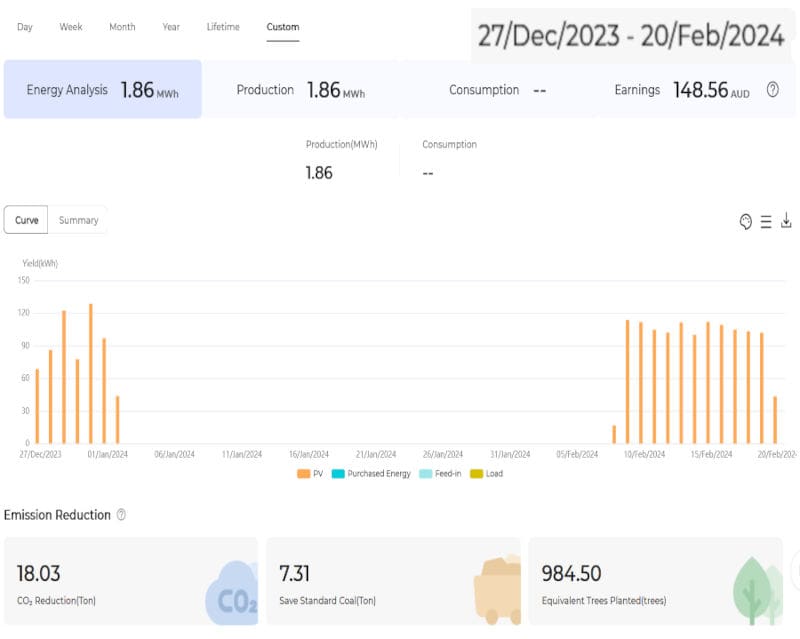
Without the internet, a month of data is missing here, but the 1.86Mwh total is recorded.
Electricity Is Fickle
If you notice small amounts of grid consumption when your battery should be handling everything, there are reasons why:
No battery system is designed to respond instantly to changes in power demand. If the programming was so snappy it reacted to every single disturbance in the grid supply, your battery would be trying to power your neighbour’s spa pump.
When something’s switched on, the inverter measures for a split second before getting on with the job. During that short lag, grid electricity will fill the gap. This can happen a hundred times an hour, and over a day, the accumulated consumption means you’re using a few watts of grid power even when your battery is working fine.
Why Does the Battery Discharge to the Grid?
The battery has to adjust its output constantly, just like the simmerstat in an electric stove switches the element on and off every 3 or 5 or 10 seconds while you’re cooking. Your solar system can’t predict these changes in load; it reacts after the energy flow is detected.
To maintain stability, your battery responds a little slower than the loads change, causing brief moments where it might pull or send energy to the grid. In the snapshot below we see:
- if 200w load were constant for a whole hour, (I’m betting it’s not)
- and you value your battery energy at 40c
- then 0.2kW x 0.35c = 8 cents per hour.
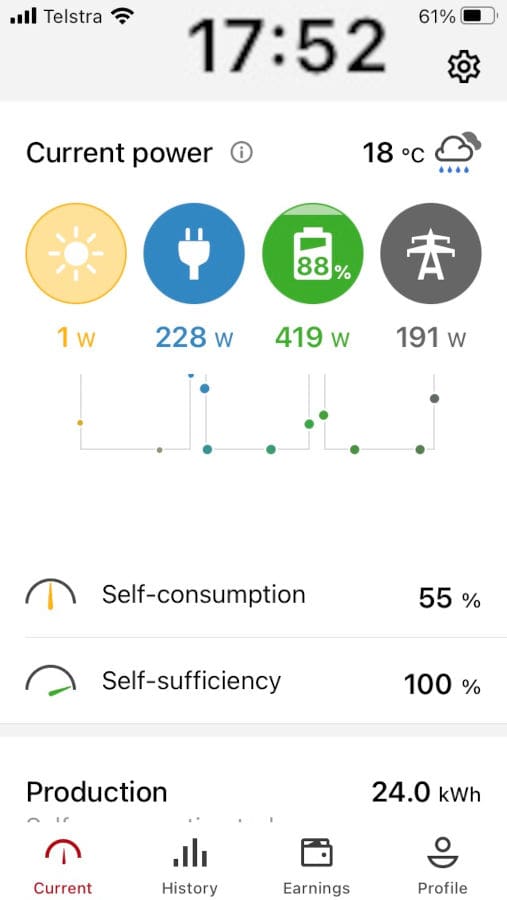
419 – 228 = 191 watts being exported to the grid, which makes little sense at 6pm
Clouding Your System’s Judgement
The other continuous variable is your solar input. If you’re using little power in the house, the battery is steadily absorbing a couple of kilowatts; then suddenly the sun breaks through, the system can be forced to deal with a spike in production.
Generally, the grid will soak up this surge, and of course, the monitoring will register it, but if your system is operating “off the grid” because there’s a power outage, there’s nowhere for this extra energy to go. As a safety precaution, the inverter may just shut down and restart, so solar and battery hybrids should not be used as an Uninterruptible Power Supply for critical loads.
Fully fledged remote area power systems are engineered to keep some headroom in the battery, never going above 98% state of charge, so there’s always some room to soak up a little extra.
Why Am I Seeing 30% More Consumption On The Bill?
If your battery remains fully charged overnight but your bills are still large, it may be due to off-peak loads or a badly wired battery. Some appliances, like hot water heaters or pool pumps, are connected to a controlled load circuit. This is a separate utility meter tail, which isn’t always monitored by your solar system. So, while they are running on cheaper(?) electricity, the solar system can neither power them nor even see the load, leading to large amounts of grid consumption being recorded on your retail bill while the solar monitoring is blind to it.
Bottom Line: These Aren’t Perfect Machines
The discrepancies seen on your solar app are just part of how these systems work. Fluctuations from a handful of watts to a few hundred are normal, data transmission isn’t perfect, and your battery system can’t react instantly to every change in power usage. If everything seems mostly right and your system was installed correctly, there’s no need to stress.
The grid will always step in to help, and those small readings on your app don’t mean your solar system is letting you down.
If You’re Not Convinced
The best way to check the veracity of your monitoring is to compare it with longer-term utility meter data, which you can find by contacting your distributor.
Mistakes are sometimes made. Installers might program the inverter for the wrong CT metering coils, meaning consumption & generation show a consistent error while generation figures are accurate.
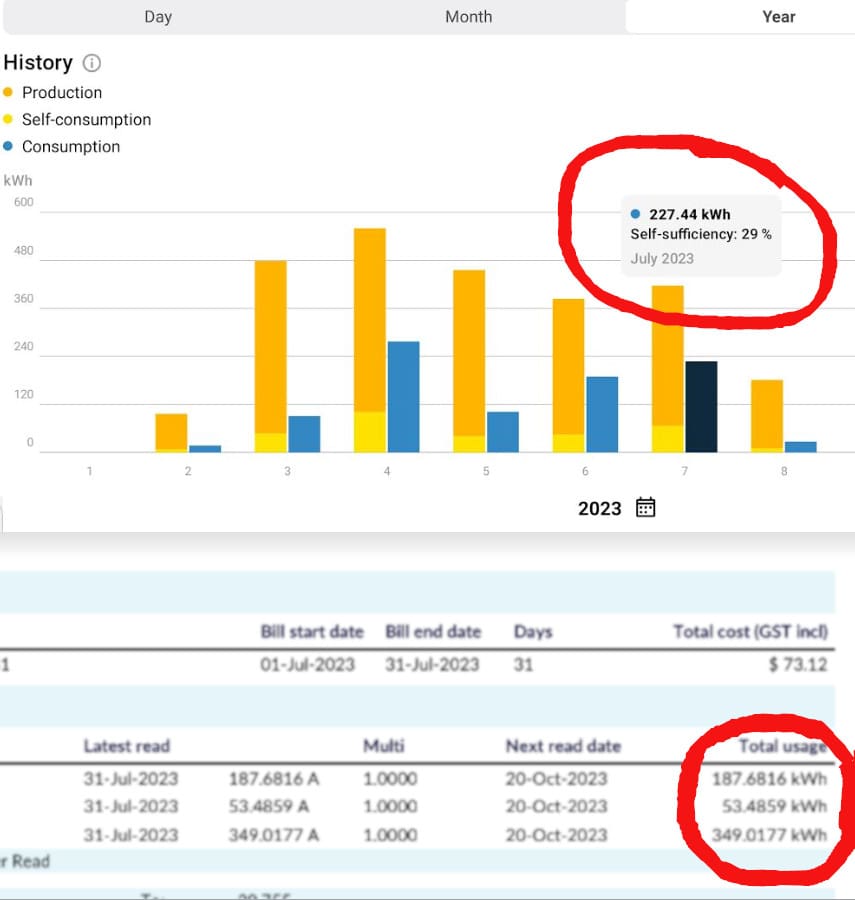
187 + 53 = 240, a number within 5% of the 227 on this monitoring graph, but it turns out this app was adding both figures when it should not have been, because the solar consumption meter was faulty.
Retail metering mechanics can also mess up an installation when they come to fit a utility “smart meter” after your solar install is finished.
If you find a significant error, contact your solar installer and ask them to check it online. Bear in mind, if they send an electrician to find out there’s nothing wrong, you may be charged a call-out fee. If you need further help, you can also contact the manufacturer support service with your name, address, e-mail, and serial numbers.
Original Source: https://www.solarquotes.com.au/blog/monitoring-apps-arent-lying/

